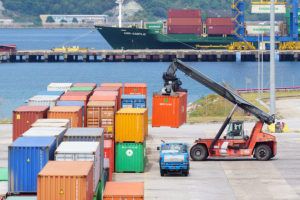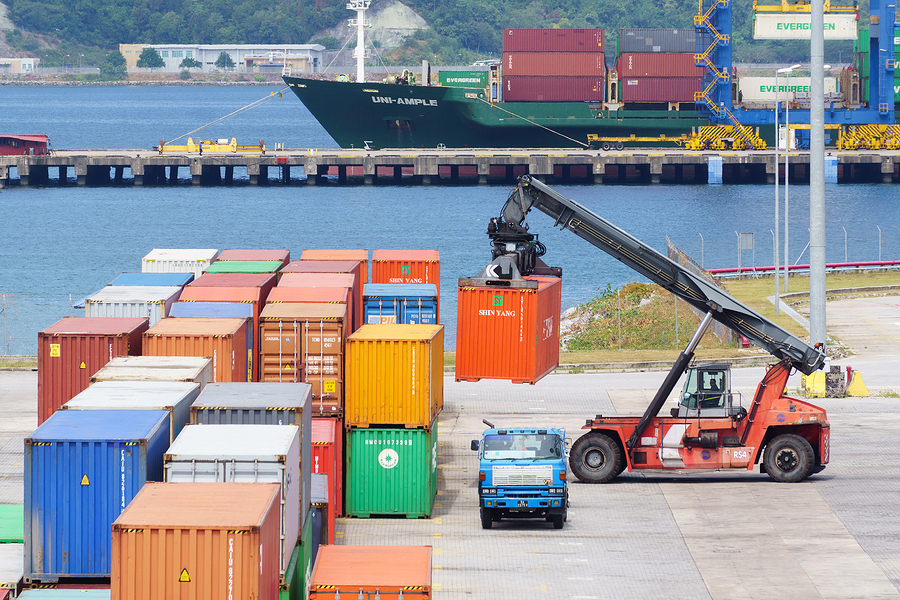In the event of a natural catastrophe, two ports in Nagoya, Japan and Guangzhou, China, would suffer the greatest losses at $2.3 billion and $2 billion respectively, according to RMS analysis of the catastrophe risk associated with the world’s ports.
In a new report, the catastrophe risk management firm ranked the top ten world ports for greatest potential loss if impacted by a natural catastrophe.
The analysis shows that the riskiest six of the top ten riskiest ports are in the U.S., with the remaining two in Europe. Surprisingly, it is not just the biggest container hubs that have a high risk of loss. Smaller ports in the U.S. such as Plaquemines, La., and Pascagoula, Miss., as well as Bremerhaven in Germany also feature in the ranking due to their cargo type and the natural hazards they face.
The findings will cause concern among marine insurers and reinsurers coming after four years of marine catastrophes which have generated billions of dollars in marine insurance losses: 2015 Tianjin explosion (est. $3 to $6 billion), 2012 Superstorm Sandy (est. $3 billion), and the 2011 Tohoku earthquake and tsunami.
PORTS AT RISK FOR HIGHEST LOSSES
(500 YEAR ESTIMATED CATASTROPHE LOSS FOR EARTHQUAKE, WIND, AND STORM SURGE PERILS)
| PORT | ESTIMATED CATASTROPHE LOSS* | |
| 1 | Nagoya, Japan | $2.3 billion |
| 2 | Guangzhou, China | $2.0 billion |
| 3 | Plaquemines, LA, U.S. | $1.5 billion |
| 4 | Bremerhaven, Germany | $1.0 billion |
| 5 | New Orleans, LA, U.S. | $1.0 billion |
| 6 | Pascagoula, MS, U.S. | $1.0 billion |
| 7 | Beaumont, TX, U.S. | $0.9 billion |
| 8 | Baton Rouge, LA, U.S. | $0.8 billion |
| 9 | Houston, TX, U.S. | $0.8 billion |
| 10 | Le Havre, France | $0.7 billion |
| * Losses rounded to one decimal place. |
“Surprisingly, a port’s size and its catastrophe loss potential are not strongly correlated,” explained Chris Folkman, director of Product Management at RMS. “For example, while China may be king for volume of container traffic, our study found that many smaller U.S. ports rank more highly for risk — largely due to hurricanes. Our analysis proves what we’ve long suspected — that outdated techniques and incomplete data have obscured many high-risk locations. The industry needs to cease its guessing game when determining catastrophe risk and port accumulations.”
To conduct the analysis the firm’s marine risk experts used the new RMS Marine Cargo Model, to calculate the 1-in-500* year loss for each port. The team employed the model’s geospatial analysis of thousands of square kilometers of satellite imagery across ports in almost 80 countries and its proprietary technique for allocating risk exposure across large, complex terminals to assess the ports’ exposure and accumulations at a granular level never achieved before in the marine sector, to highlight the risk of port aggregations.
The modeling capability, the first of its kind, takes into account:
- Cargo type (e.g. autos, bulk grains, electronics, specie)
- Precise storage location (e.g. coastal, estuarine, waterside or within dock complex)
- Storage type (e.g. open air, warehouse, container — stacked or ground level)
- Dwell time (which can vary due to port automation, labor relations and import/export ratios)
While the use of containers in shipping has hugely benefited the global economy, it has increased catastrophic risk exposures for marine insurers due to the increasing size of ships and the increasing capacities of ports and storage facilities. Larger vessels have rendered many river ports inaccessible forcing shippers to rely on seaside ports, which are more vulnerable to hurricanes, typhoons, and storm surge. Furthermore, many ports are built on landfill, amplifying their vulnerability to earthquake risk.
“The value of global catastrophe-exposed cargo is huge and is expected to continue growing,” Folkman said. “After so much catastrophe loss to the cargo line since 2011, it is clear that ‘good enough’ modeling techniques are no longer fit for purpose. Better data and modeling will enable more effective portfolio management and underwriting for this dynamic line of business.”
Source: RMS
Was this article valuable?
Here are more articles you may enjoy.


 State Farm Sued Over Policies Backed by Distressed Insurer PHL
State Farm Sued Over Policies Backed by Distressed Insurer PHL  Tricolor Trustee Plans to Sue Founder for Auto Dealer’s Collapse
Tricolor Trustee Plans to Sue Founder for Auto Dealer’s Collapse  Atmospheric River to Flood Pacific Northwest Through Week
Atmospheric River to Flood Pacific Northwest Through Week  Abbott Presses Congress for Shield Over Preemie Baby Formula Litigation That Could Cost It Billions
Abbott Presses Congress for Shield Over Preemie Baby Formula Litigation That Could Cost It Billions 